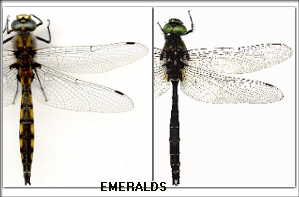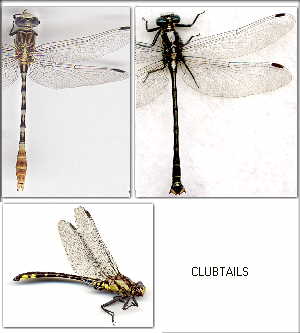California Dragonflies aka California Anisoptera
There are SEVEN families of Dragonflies in California and North America.
Read about each below these useful Dragonfly materials and select the family you would like to view.
You will be taken to a new page for that family.
Use the names below as links if you already know the family of the dragonfly you wish to access, or scroll down to choose from the photo links.
1.Skimmers - Libellulidae
2. Emeralds - Corduliidae
3. Darners - Aeshnidae
4. Clubtails- Gomphidae
5. Mixed Families (black& yellow colored)
(Click here to go to my new site for the Dragonflies of the Southwest or click here to go to my website for identifying Jalisco's Odonata. A First Guide to the Dragonflies of Jalisco)
The on-line guide begins after this introduction to some of the tools that are helpful in learning about dragonflies and damselflies in California
|
Newly AVAILABLE!! Dragonflies (Anisoptera) of California Spiral bound so it lays flat. click image for more information 
by Kathy Biggs & Sandra von Arb 2024 5.5" x 8.5" Click here to go to the book's Errata page Also available on Amazon.com as a standard/perfect bound book |
. |
Updated - May 2019 Dragonflies of California and the Greater Southwest A Beginner's Guide - 6 states - eGuide Use on your Kindle, Tablet, Smartphone or computer - weightless! Includes damselflies 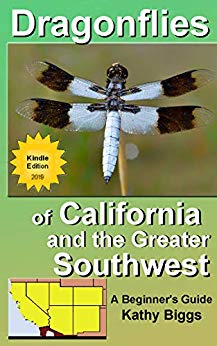
by Kathy Biggs Buy through Amazon.com (Kindle app) |
OUT OF PRINT- Sorry Revision of CA's 1st dragonfly guide: Common Dragonflies of California A Beginner's Pocket Guide (Revised Edition 2009) includes Damselflies 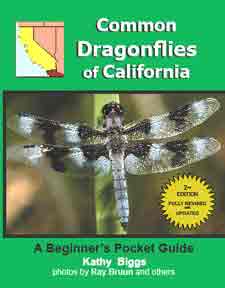
by Kathy Biggs 100 species FITS IN YOUR POCKET! Updates Also available on Amazon.com |
Available! Dragonflies of the Greater Southwest Includes ALL the species of dragonflies found in California but not the damselflies 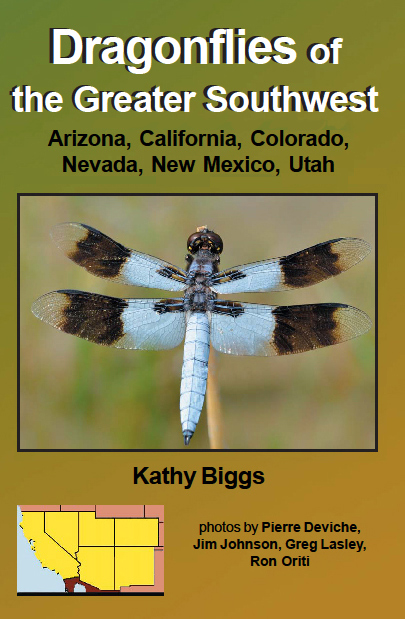
by Kathy Biggs June 2015 Updates Also available on Amazon.com |
|
Dragonflies of North America, A Color and Learn Book with Activities with Activities (also available on a CD for teachers) 
by Kathy Biggs and Tim Manolis - 2006 Includes damselflies Also available on Amazon.com |
. |
|
SORRY - OUT OF PRINT Common Dragonflies of the Southwest, A Beginner's Pocket Guide 
by Kathy Biggs 2004 Also available on Amazon.com |
2003 The COMPLETE GUIDE for CA: Dragonflies and Damselflies of California includes damselflies 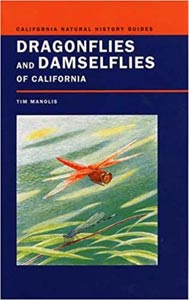
by Tim Manolis 2003 4-1/2 x 7-1/4" Also available through Amazon.com |
There are SEVEN families of Dragonflies in California and North America.
Read about each below and select/click on the family you would like to view. You will be taken to a new page for that family.
Family: SKIMMERS - Libellulidae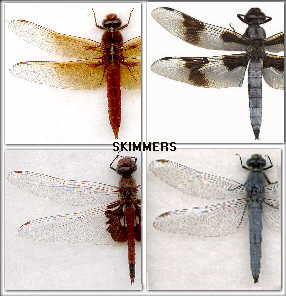
Field/Photo key to Skimmers |
Family: SKIMMERS - Libellulidae- click on name or photo to go to the Skimmers' page -17 CA genera, totaling 42 species sizes: quite variable, lengths: 23 - 65 mm males: showy nonmetallic colors; some wings patterned; bodies shorter than wingspans; eyes broadly touching females: frequently more brown or paler than males, usually having similar wing markings; most splash oviposit habitats: lakes and ponds; still waters of river pools; 2 species at moving water behaviors: most perch horizontally and fly out to hawk prey; males usually hover-guard ovipositing females while they splash eggs towards vegetation or shoreline structures. distribution: very common; found throughout the state, and at all altitudes nymph: oval body often with spines along side the abdomen and a scoop-type labium. |
Family: EMERALDS - Corduliidaearchaic name: Green-eyed Skimmers- click on name or photo to go to the Emeralds' page - 3 CA genera including Baskettails, Common and Striped Emeralds, totaling 5 species sizes: medium - with length of 42 - 55 mm males: often dark having brilliant metallic tones; some have bodies that are patterned; all have brilliant emerald green or teal green eyes with abdomens that are expanded at the midpoint - spindle shaped females: like the males except their bodies are more stout with a more even shape habitats: wooded ponds and streams, usually in the mountains behaviors: mass emergences early in season; perch by hanging; strong, fast and erratic flyers; sometimes difficult to find, scarce distribution: found in the central and northern parts of the state, often at high altitudes nymph: hairy, dark colored | |
Family: DARNERS - Aeshnidae
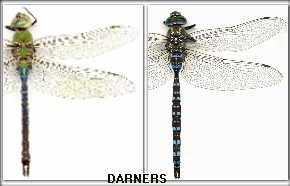 Field/Photo key to California's Darners Photo of and discussion of an Aeshna shedding its exoskeleton |
Family: DARNERS - Aeshnidae- click on name or photo to go to the Darners' page -4 CA genera, including 11 species: Darners are usually seen in-flight sizes: large, robust; fast; lengths: 56 - 111 mm males: large eyes, bodies brilliant blue and/or green with brown females: many color forms, most showing green and/or yellow instead of blue, with a background of brown and/or purple, others like male, ovipositor under tail base habitats: breed in lakes, creeks, rivers; feed over fields behaviors: usually seen in flight; patrol waterways but also often seen catching insects over fields; perch by hanging vertically; most solo oviposit into floating vegetation; some swarm; some migrate; blue coloration darkens when cool distribution: found throughout the state, at all altitudes nymph: long and tubular bodies; large eyes; actively hunt prey |
| Family: CLUBTAILS - Gomphidae
|
Family: CLUBTAILS - Gomphidae- click on name or photo to go to the Clubtails' page - 6 CA genera totaling 12 species including the Ringtails, Snaketails, Hanging Clubtails, and others sizes: large, lengths: 41 - 83 mm males: most have an enlarged area at end of abdomen; black, brown, green and/or yellow patterned; clear wings with wide stigmas; small eyes widely separated sprawling legs; well camouflaged, snakelike patterning, no blue or red coloring females: often yellow where male green; bodies cylindrical habitats: rivers, streams behaviors: males perch on ground/rocks at beach in sunlit areas; females more often found out on vegetation distribution: statewide nymph: tubular bodies tapers to the end; usually found in moving waters |
|
MIXED FAMILIES: each family has black with yellow markings 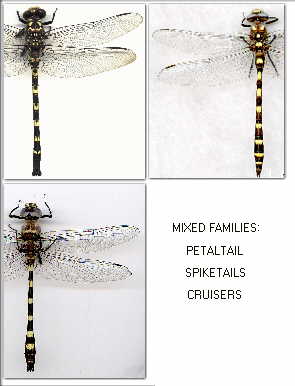 Field/photo key to black & yellow mixed families dragonflies |
MIXED FAMILIES - Black and Yellow Coloration3 CA families, each with one species, totaling 3 species: sizes: large; lengths: 54 - 85 mm males: members of these families & genera have dark background color with yellow markings on the thorax and abdomen; compare by markings, eye shape and color, and by appendage shapes females: marked like the males but bodies more stout habitats: life cycle of 2+ years in rivers, streams, seeps behaviors: Petaltail flight weak, others very strong fliers distribution: Petaltail in north; others almost statewide nymph: see individual species' links |
| End of webpage about the Anisoptera families. Use your back button to go to the opening page for the link to the Damselflies (Zygotera). |

